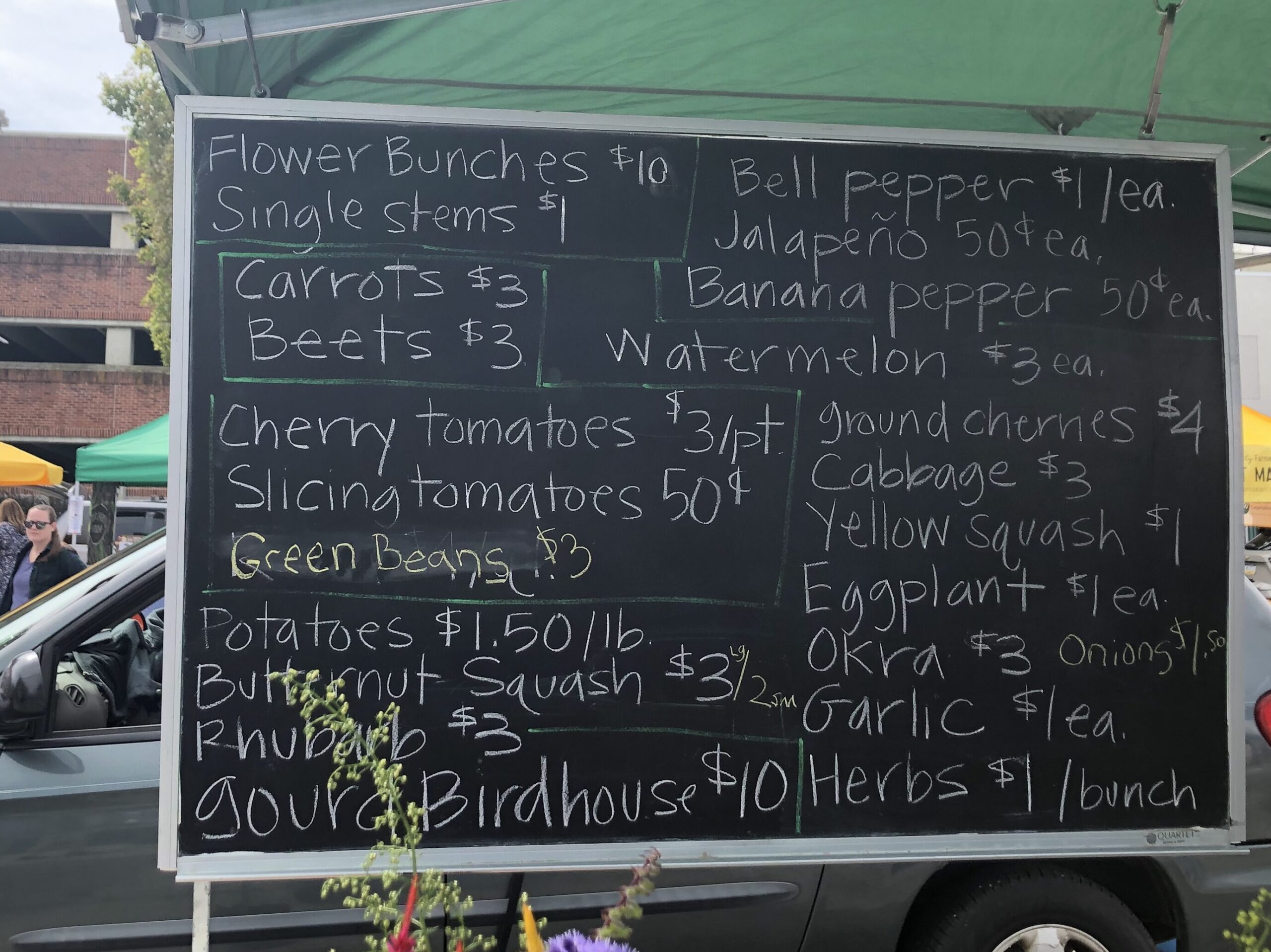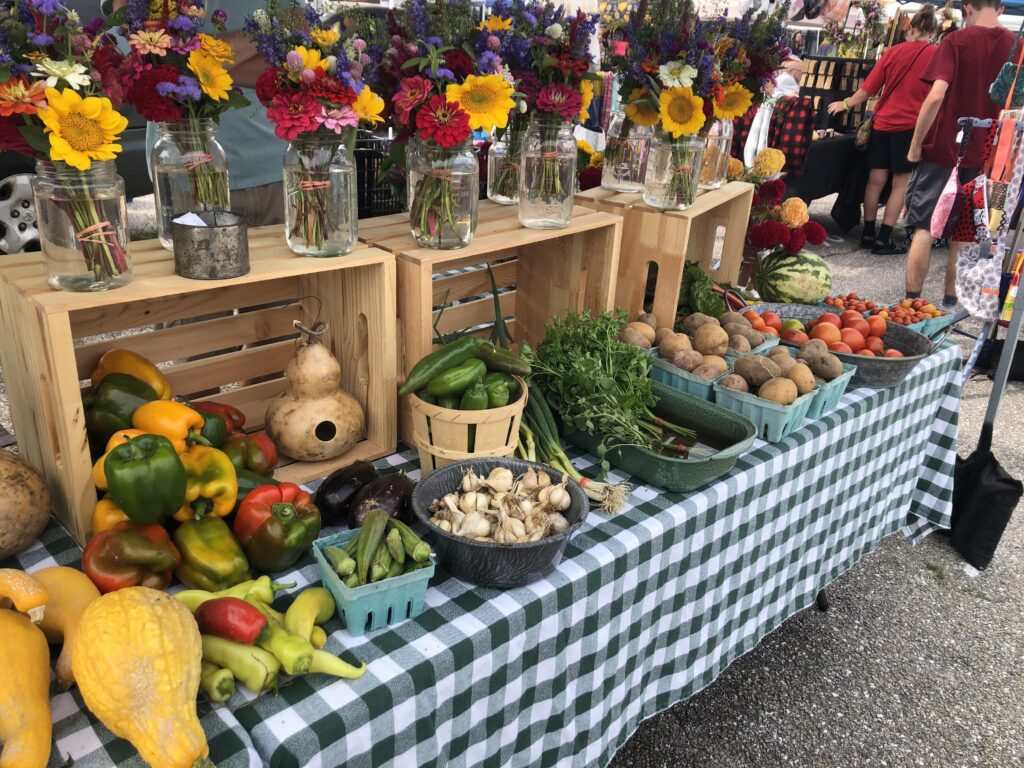Adams County Farmer’s Market Tackles Food Access and Affordability
By Alexis Jones, September 24, 2021
Community members experiencing environmental injustices are supported by the local Gettysburg farmer’s market. Last Saturday, September 11th, Gettysburg College Environmental Studies Journalism students visited the market to learn about how community members are supported by the plethora of food access and affordability programs available.
What is Environmental Justice?
“Environmental justice is the fair treatment and meaningful involvement of all people regardless of race, color, national origin, or income, with respect to the development, implementation, and enforcement of environmental laws, regulations, and policies” (EPA). Equal environmental and health protection as well as access to policymaking that determines the presence of a healthy environment are needed to ensure environmental justice (EPA).
However, these needs are not being met. Minority communities face exposure to contaminated water, unsafe workplaces, lack of safe recreational spaces, inadequate access to healthcare, preventative care, and affordable food to name a few (Ranniger 2020). Activism and policy reform can help remediate these issues. However, due to environmental injustice, social, and economic barriers, minority representation in politics is inadequate. Even with adequate political representation, policy change is slow and not guaranteed. Therefore, the real question to consider is what can communities do to foster social change from the ground up. Farmer’s markets are helping solve some of these environmental justice issues by increasing food access and affordability.
Why Do Markets and Food Programs Matter?
Markets are a great resource for the community because they provide diverse resources for community members, vendors, and beyond. Markets “provide economic revitalization and food access to local communities” (Warsaw et al., 2021, p. 8). In addition to food access, markets aid in community initiatives by “generat[ing] social capital that facilitates the pursuit of broader community objectives such as public health” (Warsaw et al., 2021, p. 5).
Program participants as well as the larger community benefit “from…enhanced access to healthy food in the socially positive community space generated by markets, wherein communities come together around food, health, jobs, economics, and the environment” (Warsaw et al., 2021, p. 8). Because a market’s success is based on its community members, their food access and affordability programs are key for providing resources to fight environmental injustices and drawing in community members.
Programs Available at Adams County Farmer’s Market
108 North Stratton Street in Gettysburg, Pennsylvania is home to the area’s local farmer’s market which serves as a hub for both community members and tourists to gather, shop, and support the Gettysburg community vendors. The market is open every Saturday from May till October. Recognizing that environmental justice issues are exacerbated for community members struggling with low income, food access, and health problems, the Adam’s County Farmer’s Market offers programs that allow community members facing hardship to access healthy food affordably.
The most widely used program is Healthy Options which allows low-come families and senior citizens to use vouchers to buy the food they may not have otherwise had the ability to purchase (Djalal). A program similar to this, in its educational purpose, is the Wellspan Market Bucks program which enables Wellspan patients to receive coaching on healthy eating and fruit and vegetable intake (Adams County Farmers Market). Wellspan Market Bucks allows pre-diabetics and diabetics to get a monthly allowance to purchase local produce at the market (Adams County Farmers Market).
Nate Stock, the owner of Hilltop Farm Market, states one of the programs most beneficial to farmers is the Farmers Market Nutrition Program (FMNP) which doubles the state benefits given to single mothers and senior citizens. Because community members are able to afford these local products, farmers and other vendors continue to profit.
Community funding from “churches, Kennies, the Adams County Food Policy Council, and various other programs” that support food access allow these programs to exist (Djalal). A large contributor to these programs is Gettysburg Hospital Foundation who, Djalal explains, sees that these programs are a valuable community investment. When community members are educated on healthy diet practices and then utilize these practices, patients and hospitals save money from having to treat illnesses related to poor diet. Community support for these programs shows that not only are those who partake in these programs able to see the benefits, but also larger corporations.

Farmer’s Market Growth
The Adam’s County Farmer’s Market is in the organization’s 10-11th year of existence and has recently increased in size due to the loss of its competitor. The market experienced a “42% increase over 2019 and is on track to increase by at least 50% in 2021” (Djalal). Market and vendor profits were also able to increase due to the COVID-19 pandemic as the market was deemed essential and able to stay open. This increased growth and access was vital for all community members, but especially those facing hardships who needed the market’s food access and affordability programs.
Great strides have been made to improve the market and its accessibility to community members facing hardships. However, there is still room for growth of the market, specifically in outreach and participation. Though these programs are available to community members, they are not being taken advantage of to the full degree.
Adams County Market serves “1,000 – 1,200 food insecure individuals a year” (Djalal). However, the bureau area population is a bit under 8,000. There are clear problems of community member participation with on average only ⅛ of the bureau utilizing these programs a year. More than an ⅛ of community members qualify for these programs, but not everyone either knows about the programs or feels comfortable enough to participate in them.
A program that faces this challenge is the SNAP “Double Dollars” program. Community members that qualify for SNAP are able to get double cash back through a token system (Adams County Farmers Market). For example, they would charge $1 to an EBT card and get $2 back in tokens. Djalal believes a lack of participation is due to community members believing this program is too good to be true and an inability to grapple with the pay first, buy later method used with the tokens. The “trick is in the mechanics” (Djalal). Therefore, proper advertisement and explanation of the program’s process is necessary. Market manager, Reza Djalal, hopes to achieve this through updates to the website and the creation of a market TikTok.

Adams County Farmer’s Market Moves Shop?
Due to infrastructure development on the current market space, the market will have to relocate. Though there are multiple location options still in the works, with new options still being revealed, some see an optimal location change being the community rec park. Will the success of the market’s programs be lost with the location change or will the new location enhance the market’s ability to combat environmental injustices?
References
Adams County Farmers Market. Increasing access to healthy food.
EPA. (2021, September 8). Environmental justice.
Ranniger, G. (2020, June 1). Environmental justice: Today zip code is still the most potent predictor of an individual’s health and well-being. Environmental Health News.
Reza Djalal. Adams County Farmers Market Manager.
Warsaw, P., Archambault, S., He, A., & Miller, S. (2021). The economic, social, and environmental impacts of farmers markets: Recent evidence from the US. Sustainability, 13(6), 3423 (1-18).
This story was updated on October 8, 2021. The primary changes include an updated Adams County Market Logo photo, hyperlinks in the reference list, updated quotes, consolidation in writing to enhance the main message of food access and affordability.



